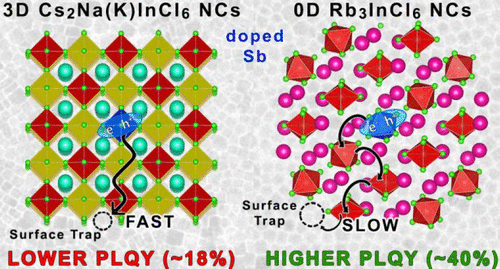当前位置:
X-MOL 学术
›
ACS Energy Lett.
›
论文详情
Our official English website, www.x-mol.net, welcomes your
feedback! (Note: you will need to create a separate account there.)
Sb-Doped Metal Halide Nanocrystals: A 0D versus 3D Comparison
ACS Energy Letters ( IF 19.3 ) Pub Date : 2021-05-27 , DOI: 10.1021/acsenergylett.1c00789 Dongxu Zhu 1 , Matteo L Zaffalon 2 , Juliette Zito 1, 3 , Francesca Cova 2 , Francesco Meinardi 2 , Luca De Trizio 1 , Ivan Infante 1 , Sergio Brovelli 2 , Liberato Manna 1
ACS Energy Letters ( IF 19.3 ) Pub Date : 2021-05-27 , DOI: 10.1021/acsenergylett.1c00789 Dongxu Zhu 1 , Matteo L Zaffalon 2 , Juliette Zito 1, 3 , Francesca Cova 2 , Francesco Meinardi 2 , Luca De Trizio 1 , Ivan Infante 1 , Sergio Brovelli 2 , Liberato Manna 1
Affiliation

|
We synthesize colloidal nanocrystals (NCs) of Rb3InCl6, composed of isolated metal halide octahedra (“0D”), and of Cs2NaInCl6 and Cs2KInCl6 double perovskites, where all octahedra share corners and are interconnected (“3D”), with the aim to elucidate and compare their optical features once doped with Sb3+ ions. Our optical and computational analyses evidence that the photoluminescence quantum yield (PLQY) of all these systems is consistently lower than that of the corresponding bulk materials due to the presence of deep surface traps from under-coordinated halide ions. Also, Sb-doped “0D” Rb3InCl6 NCs exhibit a higher PLQY than Sb-doped “3D” Cs2NaInCl6 and Cs2KInCl6 NCs, most likely because excitons responsible for the PL emission migrate to the surface faster in 3D NCs than in 0D NCs. We also observe that all these systems feature a large Stokes shift (varying from system to system), a feature that should be of interest for applications in photon management and scintillation technologies. Scintillation properties are evaluated via radioluminescence experiments, and re-absorption-free waveguiding performance in large-area plastic scintillators is assessed using Monte Carlo ray-tracing simulations.
中文翻译:

Sb 掺杂金属卤化物纳米晶体:0D 与 3D 比较
我们合成了由孤立的金属卤化物八面体(“0D”)和 Cs 2 NaInCl 6和 Cs 2 KInCl 6双钙钛矿组成的 Rb 3 InCl 6胶体纳米晶体(NCs),其中所有八面体共享角并相互连接(“3D”) ”),目的是阐明和比较它们掺杂 Sb 3+离子后的光学特性。我们的光学和计算分析证明所有这些系统的光致发光量子产率 (PLQY) 始终低于相应的体材料,因为存在来自配位不足的卤化物离子的深表面陷阱。此外,Sb 掺杂的“0D”Rb 3 InCl 6NCs 表现出比 Sb 掺杂的“3D”Cs 2 NaInCl 6和 Cs 2 KInCl 6 NCs更高的 PLQY ,很可能是因为负责 PL 发射的激子在 3D NCs 中比在 0D NCs 中更快地迁移到表面。我们还观察到所有这些系统都具有较大的斯托克斯位移(因系统而异),这一特征应该对光子管理和闪烁技术的应用感兴趣。通过辐射发光实验评估闪烁特性,并使用蒙特卡罗射线追踪模拟评估大面积塑料闪烁体中的无重吸收波导性能。
更新日期:2021-06-11
中文翻译:

Sb 掺杂金属卤化物纳米晶体:0D 与 3D 比较
我们合成了由孤立的金属卤化物八面体(“0D”)和 Cs 2 NaInCl 6和 Cs 2 KInCl 6双钙钛矿组成的 Rb 3 InCl 6胶体纳米晶体(NCs),其中所有八面体共享角并相互连接(“3D”) ”),目的是阐明和比较它们掺杂 Sb 3+离子后的光学特性。我们的光学和计算分析证明所有这些系统的光致发光量子产率 (PLQY) 始终低于相应的体材料,因为存在来自配位不足的卤化物离子的深表面陷阱。此外,Sb 掺杂的“0D”Rb 3 InCl 6NCs 表现出比 Sb 掺杂的“3D”Cs 2 NaInCl 6和 Cs 2 KInCl 6 NCs更高的 PLQY ,很可能是因为负责 PL 发射的激子在 3D NCs 中比在 0D NCs 中更快地迁移到表面。我们还观察到所有这些系统都具有较大的斯托克斯位移(因系统而异),这一特征应该对光子管理和闪烁技术的应用感兴趣。通过辐射发光实验评估闪烁特性,并使用蒙特卡罗射线追踪模拟评估大面积塑料闪烁体中的无重吸收波导性能。











































 京公网安备 11010802027423号
京公网安备 11010802027423号